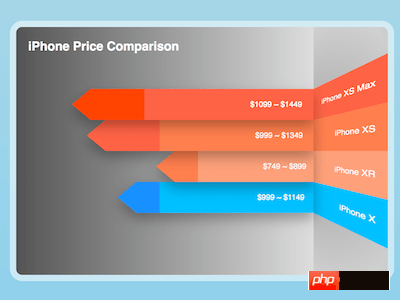
本篇文章给大家带来的内容是关于如何使用纯CSS实现iPhone 价格信息图(附源码),有一定的参考价值,有需要的朋友可以参考一下,希望对你有所帮助。

https://github.com/comehope/front-end-daily-challenges
定义 dom,容器中包含 3 个元素,h1 是图表标题,.back 表示背景墙,.side 表示侧边墙,.back 和 .side 中都包含一个无序列表,背景墙展示价格,侧边墙展示名称:
<div> <h1>iPhone Price Comparison</h1> <div> <ul> <li><span>$1099 ~ $1449</span></li> <li><span>$999 ~ $1349</span></li> <li><span>$749 ~ $899</span></li> <li><span>$999 ~ $1149</span></li> </ul> </div> <div> <ul> <li>iPhone XS Max</li> <li>iPhone XS</li> <li>iPhone XR</li> <li>iPhone X</li> </ul> </div> </div>
居中显示:
body {
margin: 0;
height: 100vh;
display: flex;
align-items: center;
justify-content: center;
background: linear-gradient(lightblue, skyblue);
}定义容器尺寸:
.wall {
width: 60em;
height: 40em;
border: 1em solid rgba(255, 255, 255, 0.5);
border-radius: 2em;
font-size: 10px;
}用 grid 布局,把容器分成 2 部分,左侧80%为背景墙,右侧20%为侧边墙:
.wall {
display: grid;
grid-template-columns: 0 4fr 1fr;
}分别设置背景墙和侧边墙的背景色:
.back {
background: linear-gradient(
to right,
#555,
#ddd
);
}
.side {
background:
radial-gradient(
at 0% 50%,
/* tomato 25%,
yellow 90% */
rgba(0, 0, 0, 0.2) 25%,
rgba(0, 0, 0, 0) 90%
),
linear-gradient(
to right,
#ddd,
#ccc
)
}用 flex 布局设置对齐方式,列表垂直居中:
.back,
.side {
display: flex;
align-items: center;
}
.back {
justify-content: flex-end;
}
ul {
list-style-type: none;
padding: 0;
}设置标题样式:
h1 {
position: relative;
width: 20em;
margin: 1em;
color: white;
font-family: sans-serif;
}设置列表项的高度和颜色:
.back ul {
width: 75%;
}
.side ul {
width: 100%;
}
ul li {
height: 5em;
background-color: var(--c);
}
ul li:nth-child(1) {
--c: tomato;
}
ul li:nth-child(2) {
--c: coral;
}
ul li:nth-child(3) {
--c: lightsalmon;
}
ul li:nth-child(4) {
--c: deepskyblue;
}至此,整体布局完成。接下来设置左侧背景墙的横条样式。
横条的宽度根据与商品的上限售价 --high-price 成正比,以最贵的售价 --max-price 作为全长,其他横条的宽度为上限售价与最高售价的百分比:
ul {
display: flex;
flex-direction: column;
}
.back ul {
align-items: flex-end;
}
ul {
--max-price: 1449;
}
ul li.xs-max {
--high-price: 1449;
}
ul li.xs {
--high-price: 1349;
}
ul li.xr {
--high-price: 899;
}
ul li.x {
--high-price: 1149;
}
.back ul li {
width: calc(var(--high-price) / var(--max-price) * 100%);
}在横条中区分起售价 --low-price 的位置,比起售价高的区域填充更深的颜色:
ul li.xs-max {
--low-price: 1099;
--c2: orangered;
}
ul li.xs {
--low-price: 999;
--c2: tomato;
}
ul li.xr {
--low-price: 749;
--c2: coral;
}
ul li.x {
--low-price: 999;
--c2: dodgerblue;
}
.back ul li {
--percent: calc(var(--low-price) / var(--high-price) * 100%);
background: linear-gradient(
to left,
var(--c) var(--percent),
var(--c2) var(--percent)
);
}在横线的顶端画出一个向左的三角形:
.back ul li {
position: relative;
}
.back ul li::before {
content: '';
position: absolute;
width: 0;
height: 0;
transform: translateX(-3em);
border-right: 3em solid var(--c2);
border-top: 2.5em solid transparent;
border-bottom: 2.5em solid transparent;
}设置价格文字样式:
.back ul li span {
position: absolute;
width: 95%;
text-align: right;
color: white;
font-size: 1.25em;
line-height: 4em;
font-family: sans-serif;
}为各横条增加阴影,增强立体感:
ul li.xs-max {
z-index: 5;
}
ul li.xs {
z-index: 4;
}
ul li.xr {
z-index: 3;
}
ul li.x {
z-index: 2;
}
.back ul li {
filter: drop-shadow(0 1em 1em rgba(0, 0, 0, 0.3));
}至此,背景墙的横条完成。接下来设置侧边墙的样式。
为了制造立体效果,需要设置侧边墙的景深,并使列表倾斜:
.side {
perspective: 1000px;
}
.side ul {
transform-origin: left;
transform: rotateY(-75deg) scaleX(4);
}设置侧边墙的文字样式:
.wall {
overflow: hidden;
}
.side ul li {
padding-right: 30%;
text-align: right;
color: white;
font-family: sans-serif;
line-height: 5em;
}至此,静态视觉效果完成。最后增加入场动画效果:
ul li {
animation: show 1s linear forwards;
transform-origin: right;
transform: scaleX(0);
}
@keyframes show {
to {
transform: scaleX(1);
}
}
.back ul li {
animation-delay: 1s;
}大功告成!
The above is the detailed content of How to use pure CSS to implement iPhone price infographic (source code attached). For more information, please follow other related articles on the PHP Chinese website!